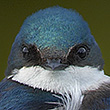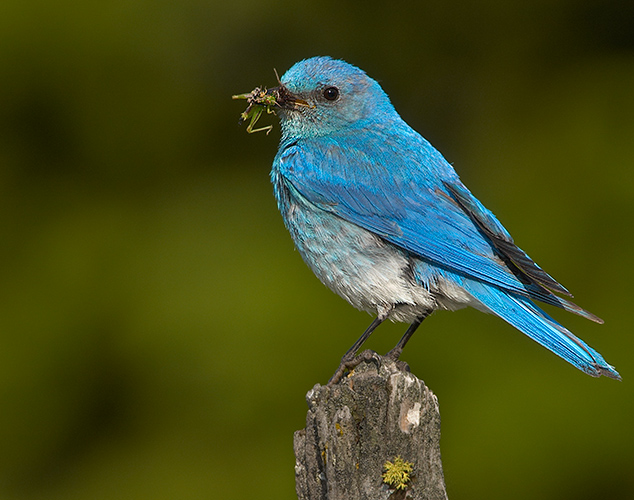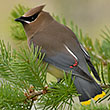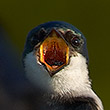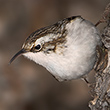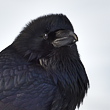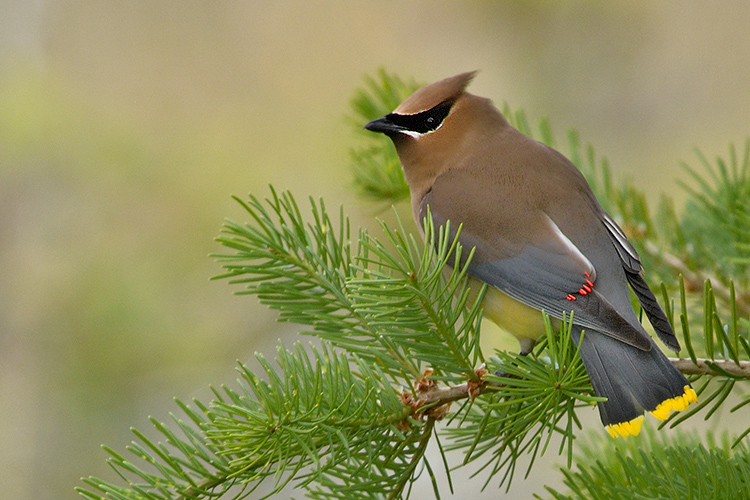
Availability: Undetermined - Enquiries?
In the Field
Cedar Waxwing on Douglas Fir. Findlay Creek, BC, Canada. June 9, 2007.
Since being a kid I've always loved both Cedar and Bohemian Waxwings. Between their amazingly "sleek" plumage and combination of subtle tone changes with dramatic colouration at the wing and tail tips, I consider them one of North America's most beautiful song birds.
I haven't had many opportunities to photograph them, so when this Cedar Waxwing flew in while I was photographing Mountain Bluebirds, I didn't hesitate to swing my lens around and forget, for a few minutes, what the bluebirds were doing!
As is probably obvious from looking at other images I've taken of songbirds, I like accentuating their feather detail, especially in their head and back. But this is virtually impossible with waxwings as their feathers are so fine they form an amazingly smooth and nearly featureless surface. The only detail that was showing in the back of this bird were some extremely fine streaks (these short streaks ARE feathers - not digital noise). So, in processing this image, I went with what the bird itself dictated - softness.
Behind the Camera
Cedar Waxwing on Douglas Fir. Findlay Creek, BC, Canada. June 9, 2007.
Digital Capture; Uncompressed RAW (NEF) format; ISO 200.
Nikon D2Xs with with Nikon 200-400 mm f/4G ED-IF AF-S VR lens @ 400 mm paired with 1.4X Nikon TC-14E II teleconverter (825 mm equivalent with digital conversion factor) supported on Gitzo 1348 carbon fibre tripod with Wimberley head. VR turned to "On" and in "Normal" mode.
1/125s @ f9; -0.33 stop exposure compensation from matrix-metered exposure setting.
At the Computer
Cedar Waxwing on Douglas Fir. Findlay Creek, BC, Canada. June 9, 2007.
RAW Conversion to 16 bit TIFF, including very light first-pass sharpening (using "soft look" option), exposure compensation, and tone curve adjustment, using Phase One's C1 Pro.
Further digital correction on 16-bit TIFF file using Adobe's Photoshop CS3 and LightZone 3. Minor tonal adjustments performed in LightZone (using the ToneMapper/Relight tool). Photoshop adjustments included selective saturation enhancement, and very light selective sharpening for web output.
Conservation
Cedar Waxwing on Douglas Fir. Findlay Creek, BC, Canada. June 9, 2007.
Ten percent of the revenue generated by this image will be donated to Wildsight.
Species Status in Canada*: This species is not designated as at risk.
The Cedar Waxwing (Bombycilla cedrorum) is a neotropical migrant that is named for the red wax-like tips of their secondary flight feathers. These highly gregarious birds can be found in very large flocks in the non-breeding season, and during the breedings season they may even nest in loose colonies. Cedar Waxwings vary from common to uncommon in their preferred habitat, which includes woodland, forest edge and farmlands with fruit trees.
This Cedar Waxwing was photographed in the Columbia Valley of the East Kootenays. Many ecosystems within the Columbia Valley face development pressure, including pressure from logging operations. While Cedar Waxwings are not directly threatened in the Columbia Valley, they do, of course, need appropriate habitat in order to continue to thrive. Wildsight is an effective conservation organization that protects biodiversity and promotes sustainable communities in Canada's Columbia and Rocky Mountains. Support for Wildsight, through donation or becoming a member, will help ensure that they remain effective in their efforts to conserve threatened or endangered species and ecosystems.
*as determined by COSEWIC: The Committee on the Status of Endangered Wildlife in Canada



















